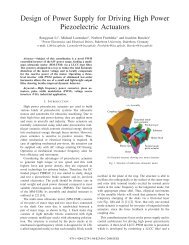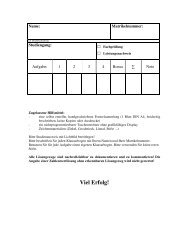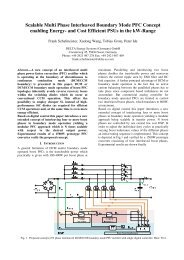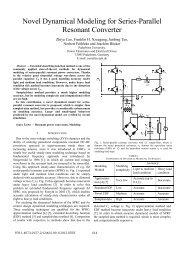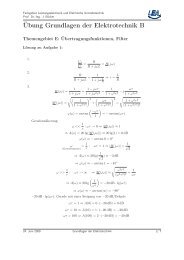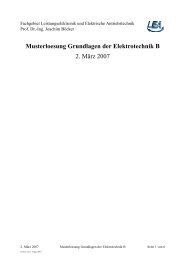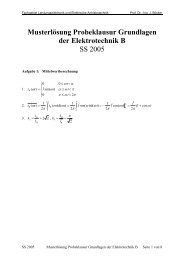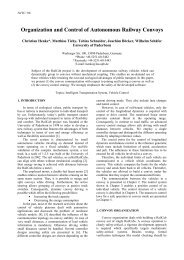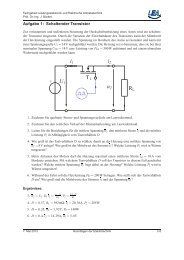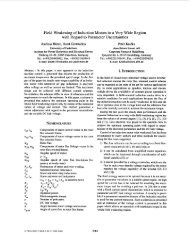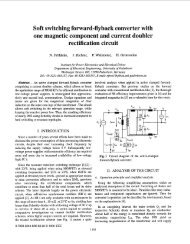Semi-Digital Interleaved PFC Control with Optimized Light Load ...
Semi-Digital Interleaved PFC Control with Optimized Light Load ...
Semi-Digital Interleaved PFC Control with Optimized Light Load ...
You also want an ePaper? Increase the reach of your titles
YUMPU automatically turns print PDFs into web optimized ePapers that Google loves.
<strong>Semi</strong>-<strong>Digital</strong> <strong>Interleaved</strong> <strong>PFC</strong> <strong>Control</strong> <strong>with</strong><br />
<strong>Optimized</strong> <strong>Light</strong> <strong>Load</strong> Efficiency<br />
T. Grote 1 , H. Figge 1 , N. Fröhleke 1 , W. Beulen 2 , F. Schafmeister 2 , P. Ide 2 , J. Böcker 1<br />
1<br />
University of Paderborn, Institute of Power Electronics and Electric Drives, Germany<br />
2<br />
DELTA Energy Systems GmbH, Soest, Germany<br />
Abstract— A control structure for an interleaved power factor<br />
correction (<strong>PFC</strong>) rectifier <strong>with</strong> smart combination of analog and<br />
digital control parts is presented in this paper. Analog technique<br />
is employed to accomplish high control bandwidth while digital<br />
control is used for parts of lower dynamic demands. This results<br />
in low microcontroller costs though the system is kept flexible.<br />
Particularly, the control strategy can be adapted depending on<br />
the operation point. Since the light load performance is in recent<br />
focus of interest, appropriate algorithms to improve light load<br />
efficiency were implemented on a prototype system and are<br />
briefly described in this paper. The effectiveness of the proposed<br />
semi-digital control approach is verified by experimental results.<br />
Keywords: power factor correction rectifier, digital control,<br />
semi-digital control, interleaving, power management,<br />
v_line<br />
additional analog circuits<br />
interleaved clock signal;<br />
PWM; current balancing;<br />
safety shutdown<br />
i_V2<br />
i_V1<br />
d*<br />
current<br />
controller<br />
i*<br />
analog single <strong>PFC</strong> controller IC<br />
_<br />
i_<strong>PFC</strong><br />
+<br />
i*<br />
voltage<br />
controller<br />
_<br />
v_bulk<br />
+<br />
v ref<br />
I. INTRODUCTION<br />
The boost power factor correction (<strong>PFC</strong>) rectifier is widely<br />
used as front-end stage for AC-DC switched-mode power<br />
supplies (SMPS). In order to split the total current and<br />
moreover to reduce the effective high-frequency ripple of line<br />
and DC link capacitor currents it is advantageous to use two<br />
parallel boost phases in an interleaved (i.e. 180° phaseshifted)<br />
manner [1-5], if the power is in the range of above<br />
1 kW.<br />
Analog control provides high bandwidth. For a multitude<br />
of applications, specific analog controller ICs are available,<br />
which are easy to understand and featuring a variety of<br />
functionalities at relative low costs. Hence, analog controllers<br />
are still dominant in <strong>PFC</strong> applications. However, in many<br />
cases these standard ICs do not meet adequately the required<br />
specifications. To fulfill those requirements, additional analog<br />
circuitry is needed as shown for example in Fig. 1 <strong>with</strong> an<br />
interleaved <strong>PFC</strong> rectifier.<br />
Recent publications [6-12] demonstrate that purely digitally<br />
controlled <strong>PFC</strong>s are feasible and exhibit a number of benefits<br />
such as flexibility and programmability, decreased number of<br />
active and passive components, and, as a consequence,<br />
improved reliability, negligible and/or compensatable offsets<br />
and thermal drifts. Additionally, digital control offers the<br />
potential of implementing sophisticated adaptive and<br />
nonlinear control methods to improve stationary and dynamic<br />
performance and to implement power management strategies<br />
to improve efficiency. However, the current control loop has<br />
to provide a much higher bandwidth than the voltage control<br />
loop. Therefore, high computing power and costly DSP would<br />
Fig. 1. <strong>Control</strong> structure for interleaved <strong>PFC</strong> rectifier realized <strong>with</strong> a<br />
single <strong>PFC</strong> controller IC<br />
be needed if going fully digital. Even fully digital control still<br />
needs some analog circuits for time-critical safety shutdown<br />
or shunt signal amplification.<br />
Considering these pros and cons, a semi-digital concept<br />
turns out as an attractive compromise:<br />
• The current controller including time-critical protection<br />
functions retains the conventional analog structure.<br />
• The voltage controller, feed-forward compensation,<br />
multiplier, PWM clock generator and non-time critical<br />
protection functions are implemented on a<br />
microcontroller.<br />
Such a solution is characterized as follows:<br />
• Because the required bandwidth of the voltage control is<br />
usually small, a cost-effective microcontroller is<br />
sufficient.<br />
• High current control bandwidth is ensured by the analog<br />
circuitry.<br />
• There is no need to apply specific analog controller ICs.<br />
• Most innovations of digital control can be realized,<br />
because issues of adaptive and nonlinear control,<br />
programmability etc. focus mainly on voltage control.<br />
• The system can be configured, controlled and monitored<br />
by Power Management Bus (PMBus) [13].<br />
The paper is structured as follows. Section II describes the<br />
mode of operation of interleaved <strong>PFC</strong> rectifier control. In<br />
Section III the structure of the semi digital control approach is<br />
proposed. The microcontroller implementation of the digital<br />
control parts is presented in Section IV. Experimental results<br />
978-1-422-2812-0/09/$25.00 ©2009 IEEE 1722
obtained on SMPS prototype of 2 kW <strong>with</strong> interleaved boost<br />
<strong>PFC</strong> rectifier are given in Section V.<br />
II. INTERLEAVED <strong>PFC</strong> CONTROL<br />
The application of two interleaved converters features a<br />
number of benefits [1-5] such as increasing power density<br />
<strong>with</strong>out the penalty of reduced efficiency, size reduction of the<br />
boost inductors and the differential-mode EMI filter.<br />
Interleaving can also significantly reduce the switching losses<br />
and the current stress of the DC link capacitor [1].<br />
The control structure of a boost <strong>PFC</strong> rectifier (cf. Fig. 1)<br />
usually consists of an outer voltage loop, controlling the DC<br />
output voltage, a multiplier to provide sinusoidal current<br />
reference value, and an inner current loop. For interleaved<br />
<strong>PFC</strong> rectifier an additional current balancing control is<br />
necessary, because natural current sharing among the stages is<br />
non-ideal in many applications.<br />
Up to now, predominantly controller ICs for single <strong>PFC</strong> are<br />
available. So, these ICs are also used for interleaved <strong>PFC</strong><br />
rectifiers. Hence, the current balancing has to be implemented<br />
<strong>with</strong> additional discrete components. That is why the PWM<br />
unit and some protection functions of the IC (for instance<br />
UCC3818) cannot be used. Fig. 2 shows the scheme for such a<br />
separate PWM <strong>with</strong> current balancing. The main portion of<br />
the comparator-input ramps consists of the rising transistor<br />
currents. Adding the time controlled PWM sawtooth signal to<br />
the current ramps increases the slopes at the comparator input.<br />
This technique is commonly known as slope compensation<br />
and prevents subharmonic oscillation in peak current<br />
controlled converters. Furthermore, it provides good current<br />
sharing of parallel converters.<br />
III. SEMI-DIGITAL CONTROL<br />
Fig. 3 shows the semi-digital control structure <strong>with</strong> the<br />
separated analog current controller, analog PWM including<br />
current balancing and the digital voltage controller. The<br />
digital control parts are implemented on a 16 bit<br />
microcontroller. Analog-to-digital converters (ADC) provide<br />
the actual values of the rectified input voltage v line and <strong>PFC</strong><br />
clock<br />
controller<br />
+<br />
+<br />
+<br />
d*<br />
+<br />
i_V 1<br />
i_V 2<br />
RS<br />
FF Q<br />
RS<br />
RS<br />
FF Q<br />
RS<br />
Fig. 2. Scheme of interleaved PWM <strong>with</strong> current balancing<br />
rectifier output voltage v bulk . There is no need of converting<br />
any currents for the control loop. Thus, only relatively slowly<br />
varying signals need to be converted, making costly ADCs<br />
<strong>with</strong> a high sample rate superfluous.<br />
By means of the control variable v bulk and the nominal<br />
output voltage reference v bulk-ref the offset v err for the voltage<br />
control algorithm is calculated (cf. Fig. 5). Measured v line<br />
values are primarily needed to synthesize the sinusoidal input<br />
current reference i * . Thereto, typically the voltage regulator<br />
*<br />
output<br />
î (proportional to current reference peak value) is<br />
multiplied by v line . In the proposed case an artificial sinusoidal<br />
waveform is used for multiplying, for which reason v line is<br />
needed to detect zero crossing and line frequency.<br />
Furthermore, the line voltage amplitude vˆ line<br />
is used for a<br />
feed-forward compensation to achieve constant input power<br />
under fluctuation of the input voltage. The output value of the<br />
digital control part is the current reference value i * for the<br />
current controller.<br />
In addition the digital part observes the range of v bulk and<br />
v line and can trigger a safety shutdown at overvoltage or<br />
undervoltage conditions.<br />
The output value i * is passed to the analog current<br />
controller (cf. Fig. 4) as pulse-width modulated signal. A<br />
simple RC low-pass filter is used as digital-to-analog<br />
converter (DAC). For current control, a PI type controller <strong>with</strong><br />
additional low pass filtering is used, which is implemented<br />
v_line<br />
Inrush<br />
v_bulk<br />
digital<br />
voltage<br />
controller<br />
i*<br />
analog<br />
current<br />
controller<br />
d*<br />
PWM<br />
&<br />
current<br />
balance<br />
i_V 2<br />
i_V 1<br />
i_<strong>PFC</strong><br />
Fig. 3. <strong>Semi</strong>-digital control structure for interleaved <strong>PFC</strong> rectifier<br />
978-1-422-2812-0/09/$25.00 ©2009 IEEE 1723
PWM<br />
signal<br />
i <strong>PFC</strong><br />
i offset<br />
i*(t) d*<br />
Fig. 4. Scheme of the analog current controller<br />
using a single op-amp. Another PWM channel also <strong>with</strong> RC<br />
low-pass filter is used for offset compensation. The actual<br />
current value i <strong>PFC</strong> is measured via shunt and after filtering and<br />
adequate scaling passed to the current controller. PWM and<br />
current balancing circuits are kept unchanged and form a<br />
complete analog subsection. Analog comparators are used for<br />
time critical safety shutdown (e.g. pulse by pulse current<br />
limiting).<br />
Some functions like soft-start or inrush current limiting are<br />
only used during start-up but nevertheless require PCB space<br />
if realized by analog components. Those functions are well<br />
suited for sequential microcontroller processing, because they<br />
can be added <strong>with</strong>out any extra costs and <strong>with</strong>out losing any<br />
performance.<br />
The presented semi-digital control is used for an<br />
interleaved <strong>PFC</strong> rectifier <strong>with</strong> two phases, but it can easily be<br />
extended for multi-phase interleaved converters <strong>with</strong>out the<br />
need of more computing power.<br />
IV. DIGITAL CONTROL IMPLEMENTATION<br />
The digital control strategy described in the previous<br />
section, as well as additional functions for monitoring, start-up<br />
and power management are implemented using the 16 bit<br />
microcontroller (Microchip dsPIC30F2020). The structure of<br />
digital control is shown in Fig. 5 <strong>with</strong> particular functions<br />
described below.<br />
A. PWM Clock<br />
The clock signal for the analog PWM module is generated<br />
by the microcontroller PWM unit. Two PWM channels are<br />
used in push-pull mode to generate two 180° interleaved clock<br />
signals <strong>with</strong> half of the PWM frequency of approx. 130 kHz.<br />
Because the PWM clock signal is generated by<br />
microcontroller, start and stop of the <strong>PFC</strong> can be controlled<br />
digitally. Furthermore, the switching frequency is kept<br />
adjustable.<br />
B. Soft Start-Up<br />
At start-up the <strong>PFC</strong> output capacitor voltage has to be<br />
raised from the pre-charged level vˆ line<br />
to the nominal output<br />
voltage v bulk-ref . In order to avoid high current surge, a soft<br />
start-up procedure is implemented. It starts by closing the<br />
inrush relay. As the delay time of the relay is known, it is<br />
forced to close at line voltage zero crossing to avoid a start-up<br />
current peak. The actual soft-start process also starts at zero<br />
crossing <strong>with</strong> multiplying a constant current reference peak<br />
*<br />
value î by line voltage v line . The result is the sinusoidal<br />
current reference value. It is passed via PWM and DAC to the<br />
analog current controller until the nominal output voltage is<br />
reached. After completing the soft-start procedure the program<br />
enters the repetitive loop <strong>with</strong> all control functions being<br />
activated.<br />
C. Voltage <strong>Control</strong>, Multiplier and Feed-Forward<br />
The digital control tasks are triggered by timer interrupt<br />
<strong>with</strong> cycle times of approx. 150µs. In every cycle, voltage<br />
control, multiplier and feed-forward compensation are<br />
computed.<br />
The voltage controller is a discrete-time PI-T 1<br />
compensator, which requires only little computing time:<br />
ˆ<br />
*<br />
ˆ*<br />
( ) ( ) ( 1) ( 1) ˆ*<br />
i n = b0v<br />
err<br />
n + bv<br />
1 err<br />
n−<br />
+ a1i<br />
n−<br />
+ a2i<br />
( n−2)<br />
. (1)<br />
v_bulk_ref<br />
PWM 1L<br />
clock A<br />
v_bulk<br />
v_line<br />
_<br />
+<br />
v_err<br />
v_line<br />
analysis<br />
voltage<br />
controller<br />
V_line<br />
i*<br />
current<br />
limiting<br />
sine LUT<br />
PWM 1H<br />
PWM 2L<br />
clock B<br />
i offset<br />
digital to analog<br />
conversion<br />
(DAC)<br />
soft-start<br />
i*(n)<br />
PWM 2H<br />
i*(t)<br />
inrush relay<br />
v_cc<br />
monitoring<br />
high/low-line<br />
enable <strong>PFC</strong><br />
Temp<br />
microcontroller<br />
Fig. 5. Block diagram of the digital control structure implemented on microcontroller<br />
v_bulk_OK<br />
978-1-422-2812-0/09/$25.00 ©2009 IEEE 1724
The controller output provide the current reference peak<br />
*<br />
value î , which has to be multiplied by line phase to<br />
achieve the sinusoidal reference waveform. The current<br />
reference value is not directly multiplied by the measured<br />
line voltage but by using a look-up table (LUT) containing<br />
the sine data (cf. Fig. 5). A counter is reset every line<br />
voltage zero crossing and gives the instantaneous line<br />
phase which is used to obtain the matching sine table entry.<br />
Using a sine table simplifies adjustment of systematic<br />
phase errors caused by ADC, DAC, computational time,<br />
etc. Another advantage of using an artificial sine wave is<br />
the simplified calculation of the feed-forward<br />
compensation. If the line voltage is directly used for<br />
multiplying, feed-forward compensation has to be<br />
accomplished by dividing by the square value of line<br />
voltage amplitude to achieve constant input power at input<br />
voltage changes. Because of the constant amplitude of an<br />
artificial sine there is no need to square. The equivalent<br />
implemented equation is:<br />
iˆ<br />
( n)<br />
v ( k)<br />
= . (2)<br />
*<br />
* ⋅<br />
sin e<br />
( n)<br />
vˆ<br />
line<br />
i<br />
The amplitude value of input voltage vˆ line<br />
is updated<br />
once in a half-cycle. The counter value k is reset every zero<br />
crossing and represents the index of the sine table entry.<br />
A problem of using a sine table <strong>with</strong> fixed length is to<br />
guarantee a high power factor under a wide range of line<br />
frequency (47 Hz – 63 Hz). Therefore a phase-locked loop<br />
(PLL) is implemented, which slightly changes the timer<br />
interrupt spacing. However, these timer adjustments affect<br />
the performance of the discrete-time voltage regulator (1).<br />
Thus, three sine tables are used to minimize timer interrupt<br />
variance.<br />
D. Power Management Features<br />
1) Adaptive Current Limiting<br />
In order to avoid overstressing of the devices the current<br />
has to be limited. However, for short-term duration an<br />
overcurrent up to 125 % of I nominal is acceptable (cf. Fig. 5).<br />
Therefore an algorithm is implemented which allows<br />
intermediate overcurrent considering the past loading<br />
conditions of the converter. No overcurrent is allowed<br />
when the power supply is stationary running at full load.<br />
Assuming that the current loop works correctly the<br />
current reference value is used for the algorithm, thus there<br />
is no need to convert the actual current value into the digital<br />
world. Fig. 6 illustrates the current limiting process from<br />
20 % and 80 % initial load.<br />
2) Phase Shedding<br />
One advantage of using interleaved phases is the<br />
potential to adjust the number of energized phases based on<br />
the load conditions. Thus it is possible to enhance the<br />
efficiency at light load conditions [3-4]. Switching between<br />
single phase and interleaved operation occurs <strong>with</strong><br />
hysteresis, i.e. one phase is switched off, if output power is<br />
iout / %<br />
150<br />
125<br />
100<br />
80<br />
50<br />
20<br />
limited current<br />
i* (requested current)<br />
lagging curves of<br />
thermal model<br />
i* lim20%<br />
i* lim80%<br />
-5 0 5 10 15 20 25<br />
t/ ms<br />
Fig. 6. Current limiting after load step from 20% and 80% load<br />
below 40 % of the rated power for a defined duration and<br />
switched on again when the output power exceeds 45 %.<br />
While running in single phase mode, the energized phase<br />
alternates between the two phases in order to achieve equal<br />
thermal stress of all <strong>PFC</strong> components.<br />
3) DC Link Voltage Reduction<br />
In many applications the <strong>PFC</strong> output capacitor supports<br />
two functions: First filtering the inductor current and<br />
second providing energy in ‘hold up’ case at line power<br />
failure (e.g. for one line period). However, since the stored<br />
energy depends on the output voltage, the output voltage<br />
can be reduced at light load. This measure leads to an<br />
improved efficiency of the <strong>PFC</strong> stage and the DC-DC stage<br />
at light load. Switching losses of both stages strongly<br />
depend on the DC link voltage (which is semiconductor<br />
blocking voltage) and decrease significantly <strong>with</strong> reduced<br />
voltage level.<br />
4) Adaptive Switching Frequency<br />
Another method to improve the efficiency is to reduce<br />
switching losses by an adaptive lowering of the switching<br />
frequency. This is feasible because the <strong>PFC</strong> boost<br />
inductance is nonlinear but depends on the actual current<br />
value. Hence, at lower current and therefore increased<br />
inductance the switching frequency can be reduced, while<br />
the current ripple is still kept under limit. This<br />
circumstance is utilized twice, firstly <strong>with</strong>in every sine<br />
half-wave of line current (Fig. 7) and secondly depending<br />
on the DC output current, which defines the line current<br />
amplitude (i.e. lower switching frequency at lower load).<br />
V. PROTOTYPE AND MEASUREMENT RESULTS<br />
The prototype was build up on the basis of a standard<br />
industrial AC-DC converter that was modified in order to<br />
test the proposed control strategy. Fig. 8 shows this 2 kW<br />
power supply <strong>with</strong> wide range AC input (90 V – 265 V;<br />
47 Hz – 63 Hz). The AC-DC stage is an interleaved boost<br />
<strong>PFC</strong> rectifier <strong>with</strong> 400 V nominal DC output voltage.<br />
978-1-422-2812-0/09/$25.00 ©2009 IEEE 1725
100%<br />
75%<br />
Line Current<br />
(100V/div)<br />
i line<br />
50%<br />
f s<br />
100%<br />
25%<br />
Switching Frequency<br />
75%<br />
(5A/div)<br />
0<br />
50%<br />
0 2 4 6 8 10<br />
t / ms<br />
Fig. 7. Switching frequency dependent on the instantaneous<br />
current value during line half-cycle<br />
The DC-DC stage consists of an interleaved two transistor<br />
forward converter <strong>with</strong> 48 V DC output. In a first step the<br />
digital control algorithms were implemented on a<br />
Microchip 16 bit-microcontroller, type dsPIC30F2020,<br />
which offers more calculation performance than actually<br />
needed for this application. After identifying the actual<br />
demand of computing power, a 16 bit microcontroller<br />
(PIC24FJ16GA002) <strong>with</strong> approx. half the calculation<br />
performance could be used <strong>with</strong>out restriction of any kind.<br />
The microcontroller costs could be reduced by more than<br />
50 % <strong>with</strong> this choice.<br />
By replacing the multitude of analog components by<br />
microcontroller the required PCB space for <strong>PFC</strong> control is<br />
reduced significantly. The performance of the modified<br />
power converter was verified by extensive experimental<br />
testing. Selective results are presented in the following.<br />
The measured input voltage and current waveforms of<br />
the prototype are shown in Fig. 9. As can be seen, the input<br />
current replicates the line voltage waveform accurately.<br />
Fig. 10 shows the start-up process of the prototype. The<br />
soft-start procedure sets a constant current reference value<br />
*<br />
î , until the output capacitor voltage reaches the reference<br />
output voltage v bulk-ref . The soft-start duration depends on<br />
the pre-charged level vˆ line<br />
and the preset current reference<br />
value.<br />
i*<br />
Fig. 9. Line voltage and current waveform<br />
v bulk_ref<br />
v bulk<br />
v line<br />
i line (5A/div)<br />
Fig. 10. Soft start-up process<br />
i*<br />
(from DAC)<br />
microcontroller<br />
v bulk, AC<br />
(10V/div)<br />
i line<br />
(5A/div)<br />
i*<br />
(from DAC)<br />
Fig. 8. Modified 2 kW AC-DC converter system<br />
Fig. 11. Transient response for load change (250 W – 500 W)<br />
978-1-422-2812-0/09/$25.00 ©2009 IEEE 1726
Fig. 11 shows a 250 W – 500 W load step transient<br />
response. The response time and the voltage overshoot are<br />
in an acceptable range and match the implemented<br />
controller dynamics.<br />
For evaluating the effectiveness of implemented power<br />
management features the efficiency for different load<br />
conditions is measured <strong>with</strong> and <strong>with</strong>out power<br />
management features activated. The resulting efficiency<br />
improvement for the <strong>PFC</strong> stage, the DC-DC stage and the<br />
sum of both are given in Fig. 12. Particularly, at light load<br />
the efficiency is improved significantly by implemented<br />
strategies. The efficiency improvement in the DC-DC stage<br />
is based only on lowering the <strong>PFC</strong> output voltage - and this<br />
turned out to be the most effective measure for the overall<br />
efficiency improvement.<br />
VI. CONCLUSIONS<br />
<strong>Digital</strong> control offers potential for applying advanced<br />
algorithms to enhance the control performance. However, it<br />
is not essential to implement a full digital control structure<br />
to achieve high flexibility. It has been shown that almost<br />
the same performance can be achieved when only realizing<br />
the low bandwidth voltage control in a digital manner. By<br />
retaining the relative fast control functions in analog<br />
technique, there is no need of high computing power,<br />
which decreases microcontroller costs significantly.<br />
The presented semi-digital control has been applied for<br />
an interleaved <strong>PFC</strong> rectifier <strong>with</strong> two phases, but it can<br />
easily be extended for multi-phase interleaved converters<br />
<strong>with</strong>out the need of more computing power.<br />
In particular, <strong>with</strong> semi-digital control the following<br />
results have been accomplished:<br />
• Adaptive current limiting strategy to permit short-time<br />
overcurrent up to 125%.<br />
• Efficiency improvement up to 4% at light load only by<br />
means of control as phase shedding, lowering of <strong>PFC</strong><br />
output voltage and of switching frequency.<br />
• Easy implementation of soft start-up to avoid current<br />
surge<br />
Efficiency Improvement<br />
4,0%<br />
3,5%<br />
3,0%<br />
2,5%<br />
2,0%<br />
1,5%<br />
1,0%<br />
<strong>PFC</strong> DC-DC Overall<br />
0,5%<br />
0,0%<br />
10 20 30 40 50 60 70 80 90 100<br />
load / %<br />
Fig. 12. Improvement of efficiency by implemented power management features<br />
VII. REFERENCES<br />
[1] L. Balogh, R. Redl, “Power-factor correction <strong>with</strong> interleaved boost<br />
converters in continuous-inductor-current mode”, Applied Power<br />
Electronics Conference and Exposition, APEC 1993. Eighth Annual<br />
IEEE, pp. 168-174, 1993<br />
[2] P. Zumel, O. Garcia, J.A. Cobos, J. Uceda, “EMI Reduction by<br />
Interleaving of Power Converters”, Applied Power Electronics<br />
Conference and Exposition, APEC 2004. Nineteenth Annual IEEE,<br />
pp. 688 - 694 vol.2, 2004<br />
[3] Zumel, C. Fernandez, A. de Castro, O. Garcia, “Efficiency<br />
improvement in multiphase converter by changing dynamically the<br />
number of phases”, Power Electronics Specialists Conference, 2006.<br />
PESC '06. 37th IEEE, pp. 1 - 6, June 2006<br />
[4] H. Wetzel, N. Fröhleke, J. Böcker, P. Ide, „High Efficient 3kW<br />
Three-Stage Power Supply”, Applied Power Electronics Conference<br />
and Exposition, APEC 2006, Twenty-First Annual IEEE<br />
[5] H. Figge, T. Grote, N. Fröhleke, J. Böcker, P. Ide, „Paralleling of<br />
LLC resonant converters using frequency controlled current<br />
balancing”, Power Electronics Specialists Conference, PESC 2008,<br />
IEEE, pp. 1080 - 1085<br />
[6] D. Maksimovic, R. Zane, R. W. Erickson, “Impact of <strong>Digital</strong> <strong>Control</strong><br />
in Power Electronics”, IEEE International Symposium on Power<br />
<strong>Semi</strong>conductor Devices and ICs, pp. 13-22, May 2004<br />
[7] A. Prodic, J. Chen, D. Maksimovic, R. Erickson, “Self-tuning<br />
digitally controlled low-harmonic rectifier having fast dynamic<br />
response”, IEEE Trans. on Power Electronics 18(1), 420-428, 2003<br />
[8] A. Prodic, D. Maksimovic, R. Erickson, “Dead-zone digital<br />
controllers for improved dynamic response of low harmonic<br />
rectifiers”, IEEE Trans. on Power Electronics, vol. 21(1), 173-<br />
181, Jan. 2006<br />
[9] S. Buso, P. Mattavelli, L. Rossetto, G. Spiazzi, “Simple digital<br />
control improving dynamic performance of power factor<br />
preregulators”, IEEE Trans. on Power Electronics, vol. 13(5), 814-<br />
823, 1998.<br />
[10] A. H. Mitwalli, S. B. Leeb, G. C. Verghese, and V. J. Thottuvelil,<br />
“An adaptive digital controller for a unity power factor converter,”<br />
IEEE Trans. on Power Electronics, vol. 11, pp. 374-382, Mar. 1996.<br />
[11] P. Zumel, A. de Castro, O. Garcia, T. Riesgo, J. Uceda, “Concurrent<br />
and simple digital controller of an AC/DC converter <strong>with</strong> power<br />
factor correction,” Applied Power Electronics Conference and<br />
Exposition, APEC 2002. Seventeenth Annual IEEE', pp. 469-<br />
475vol.1.<br />
[12] W. Zhang, G. Feng, Y. Liu, B. Wu, “A <strong>Digital</strong> Power Factor<br />
Correction (<strong>PFC</strong>) <strong>Control</strong> Strategy <strong>Optimized</strong> for DSP”, IEEE Trans.<br />
on Power Electronics, Page(s):1474 - 1485, Nov. 2004.<br />
[13] R. V. White, D. Durant, “Understanding And Using PMBus Data<br />
Formats”, Applied Power Electronics Conference and Exposition,<br />
APEC 2006. Twenty-First Annual IEEE, Page(s):7 pp., March 2006.<br />
978-1-422-2812-0/09/$25.00 ©2009 IEEE 1727



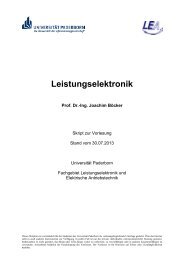

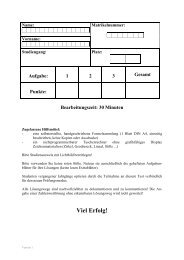
![[ ] Ï - Fachgebiet Leistungselektronik und Elektrische Antriebstechnik](https://img.yumpu.com/51151382/1/184x260/-i-fachgebiet-leistungselektronik-und-elektrische-antriebstechnik.jpg?quality=85)
